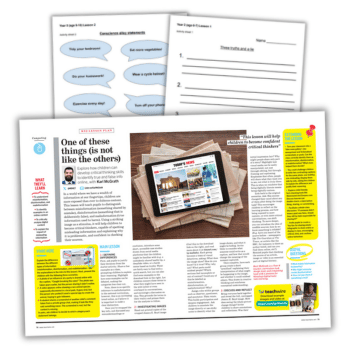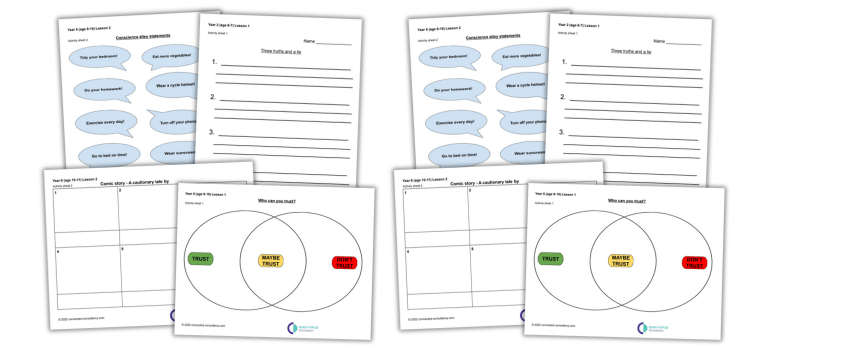Critical thinking – What it is, how to teach it and why it’s important

How to equip pupils with critical thinking skills and why it matters in a world of fast technological change…

- by Teachwire
- Classroom expertise and free resources for teachers

Like it or not, AI is already entering our everyday lives and will continue to do so at incredible speed. Given the revolutionary shifts to come, it’s important that we focus on teaching critical thinking skills if we’re to equip students for a future we can’t quite fully imagine yet.
But what’s the best way to teach critical thinking skills and why does it matter so much? Join us as we explore the topic…
What is critical thinking?
In simple terms, critical thinking is the ability to evaluate, question and contextualise a concept in order to engage with it fully.
Why is critical thinking important?
Young people’s worlds are awash with claims of dubious knowledge. From fake news to lying politicians and seductive invitations to adverts for cosmetics, the list goes on.
If they’re to successfully navigate their way through it all, they’ll need both the skill and inclination to question what they read and hear.
The rise of AI
In a world where AI is becoming increasingly ubiquitous, there are specific key skills we need to consider teaching to help pupils to thrive. This ranges from digital literacy to the development of strong communication skills and empathetic faculties.
Critical thinking is perhaps the most important of all these skills. Given that AI is able to store vast quantities of data in ways humans aren’t capable of, the emphasis of critical thinking in future will likely relate more to emotional perspectives, idea creation and decision making.
In fact, we could witness a change in the very nature of pedagogy in our lifetimes, given that the attainment of information in itself won’t be enough for success in future. Instead, it will be how a person engages with information that really matters.
All being well, the next generation will benefit from working in collaboration with AI, rather than by trying to compete with it.
Critical thinking lesson plans

The Open Minds Foundation has developed a range of critical thinking lesson plans for primary pupils. Download sample lesson plans for Years 2, 5 and 6, covering the following topics:
- Why do people tell lies?
- How do you know who to trust?
- What is manipulation and how can we be aware of it?
- Who can we trust online?
Benefits of learning critical thinking skills
Curiosity
Developing critical thinking skills among pupils has a wide range of benefits. Firstly, it encourages curiosity. Pupils who are taught to think critically inherently have a deeper curiosity about the subjects and topics presented to them in class.
It encourages them to ask important questions about even the simplest of topics, questioning the status quo and discovering a richer level of understanding.
Asking these ‘curiosity questions’ like, ‘What’s happening?’, ‘Why is it important?’, and ‘What’s hidden?’ develops lifelong learners who go on to have a greater appreciation for others’ perspectives and explore issues with a critical eye.
Creativity
Secondly, and somewhat surprisingly, critical thinking enhances pupils’ creativity. This follows critical analysis of issues and problem-solving that often calls for creative solutions and thinking ‘outside the box’, which transcend more conventional boundaries.
With critical thinking comes a freedom from obstacles that may hinder those who haven’t developed critical thinking skills, allowing for more constructive outcomes.
Problem-solving
Perhaps the most obvious benefit of critical thinking is the well-honed problem-solving skills that follow. Developing critical thinking allows us to make better-informed decisions and use reason to achieve the most effective results.
Assessing problems from all manner of angles and perspectives allows pupils to strategically work through the problem or challenge, consider the pros and cons of different solutions and rationally select the path most likely to succeed.
Keeping the ‘curiosity questions’ in mind, these also apply to the critical thinking approach to problem-solving which considers additional questions such as, ‘Where did this come from?’; ‘How do I know this?’; ‘Why should I trust this source?’; ‘What other information should I consider?’.
All told though, each of these benefits of critical thinking work in tandem to develop independent learners who are empowered to think and make decisions for themselves – an objective that I’m sure all teachers will agree, is central to our job as educators.
How to improve critical thinking skills in school
The best way of teaching critical thinking is to give students material they can think critically about, time to do that, and opportunities to share and interrogate each other’s strategies.
Here are some things you can try out in the classroom to help build healthily sceptical dispositions among your cohort…
Talk frankly about AI
Help to prepare pupils for the future by highlighting both the benefits and limitations of AI. Encourage open discussion about the ethics that underpin it.
Start with yourself
Encourage students to question your knowledge claims (politely and intelligently, of course). Respond with appreciation when someone says, ‘But how do we know that’s true, Miss?’ Say, “Good question. How could we check?”
Critique the media
Discuss common flaws in reasoning – such as claiming a causality from a correlation – and give students articles to critique, both solo and collaboratively, that illustrate these flaws.
Scrutinise the class itself
Give students guided practice in reading and critiquing each other’s draft essays or reports. Discuss criteria and rubrics with them, and sharpen their ability to give incisive, practical and respectful feedback – and to accept it as helpful, rather than hurtful.
Take it online
Provide focused advice on how students can check information online. For example, don’t just check the features of a website – search for other websites that might critique the one you’re interested in.
Plan for critical thinking time
As with all aspects of teaching, planning is key so keep this in mind when planning future lessons by allowing extra time for pupils to test their analytical and critical thinking skills.
Make connections to the real world
We all know that real-world examples help give pupils greater purpose to their learning, so integrate practical applications and activities that will allow them to see how they can apply their knowledge and skills in real life.
Encourage reflection to think about concepts
Critical thinking isn’t restricted to critiquing the knowledge and views of others, it is also about discovering our personal bias.
Try creating an online space where questions, thoughts and ideas can be shared. This also creates a safe sharing space for pupils who are reluctant to speak up in front of their peers.
Pose questions
Develop your own set of ‘curiosity questions’ and challenge pupils at the end of each class. This leaves them with something to think about overnight and creates a valuable way of connecting the dots during future lessons.
Equally, you can ask the same question at the beginning of the class, and pupils can use the duration of the lesson to come up with solutions and suggestions, as individuals or collectively.
Get active
Read a statement to your class that has two opposing views. Ask pupils to stand on either side of the room to represent their opinion and move around as their views evolve with each subsequent ‘curiosity question’.
Think about learning strategies
Ask students to evaluate how successful a specific learning strategy was for them and how they could improve.
Then, as they progress through school, encourage students to transfer strategies from one specific situation to another that’s similar, but otherwise unfamiliar. Ask them ‘How will you learn this?’ or ‘What strategy will you use to support your learning or approach this type of problem?’
Thanks to the following people for contributing to this article:
Gavin McLean is international business development director at Edmentum International.
Chris Griffths is founder of the AI-powered mind mapping app Ayoa, a keynote speaker and co-author with Caragh Medlicott of The Creative Thinking Handbook (£16.99, Kogan Page).
Guy Claxton is visiting professor of education at King’s College London. He is author of The Future of Teaching: And the Myths That Hold It Back. For more information, visit guyclaxton.net.







